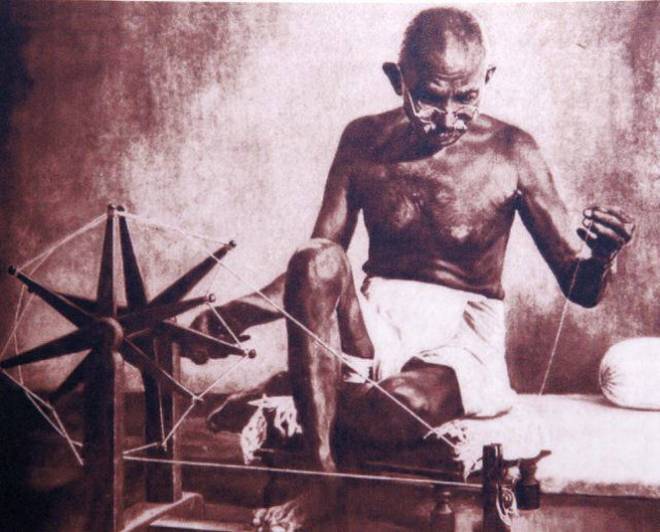Khadi Mark Regulations, 2013, Khadi India Trade Mark: An Analysis
Siby K. Joseph

In order to regulate the production, sale or trading of Khadi and Khadi products in India the Government of India vide Gazette Notification No. 3212 GI/2013 dated 22 nd July 2013 had issued the Khadi Mark Regulations, 2013. The Khadi Mark Regulations, 2013 was notified for the purpose of authentication of genuine khadi, as defined in the KVIC Act i.e. any cloth woven on handlooms in India from cotton, silk or woollen yarn hand-spun in India or from a mixture of any two or all of such yarns, by affixing the Khadi Mark Tags and Labels issued by the Commission by the persons and certified khadi institutions producing, selling or trading in khadi and khadi products. The regulations have come into force from 2nd October 2013.
From the effective date of Khadi Mark notification, no textile shall be sold or otherwise traded by any person or certified khadi institution as khadi or khadi products in any form or manner without it bearing Khadi Mark tag or label issued by Committee. They shall affix Khadi Mark tag or label or both as may be decided by the Commission from time to time. Khadi Mark Protocol issued by the KVIC says that Khadi Mark tags or woven labels will not be applicable to Polyvastra and its products. The key objectives of Khadi Mark are the following : a. Guarantee genuineness of Khadi and Khadi products produced in India – “Hand Spun, Hand Woven and Natural Fibre” b. Establish an unique identity for Khadi c.Improved customer awareness. and d. Increase popularity of Khadi.
As a result of this regulation, the khadi sector which was earlier highly decentralized became highly centralized and completely under government control. It is stated that the Khadi Mark can be obtained by a certified Khadi institution or a person engaged in production or sale or trading or combination of these in Khadi and Khadi products. However, in reality the regulation restricts the entry to a few approved entities rather than small producers. It is evident from the eligibility conditions for the registration. The important conditions of eligibility for Registration of New Khadi Institutions are as follows:
1. Applicant should be registered under the Co-op. Society/ Trust/Societies Act/Partnership Firm and Company’s Act/ Individual/Proprietor or under any other prevailing Act, fulfilling the under mentioned norms for taking up khadi activities. The applicant should declare in their Bylaws or Memorandum of Association etc. i.e. Khadi is one of the activities.
2. (a) Applicant should have owned or rented or leased property with minimum 5 years lease period having adequate space for carrying out Khadi activities
or
(b) The applicant can also start Khadi activities by providing charkhas and looms to the artisans at their home.
3. Applicant shall furnish the list of 25 spinners, 5 weavers and 2 supervisors for Cotton/ wollen khadi activities. For silk khadi activities, the list shall be provided for 6 reelers, 5 weavers, 4 other allied artisans and 2 supporting staff. …
4. The applicant should have Minimum 25 Charkhas (NMC/Deshi) and 5 looms to start the Cotton/ woolen Khadi activities. In case of silk activities, the applicant should have minimum 6 reeling basins and 5 looms. In case the applicant is not having the adequate infrastructure as stated above (for cotton/woolen/silk) at the time of filing the application, this infrastructure can be put in place after the provisional certificate is obtained…..
In addition, in order to authenticate the product being produced or sold or traded by persons as Khadi or Khadi product, Commission shall engage accredited agencies to visit the place of production, godown or sales outlet etc to undertake verification of production process and testing of khadi and khadi products before issue of Khadi Mark Registration. Even the fees for registration stands as a deterrent for small producers to enter into the sector. It led to the entry of large companies in the sector like Raymond,Arvind, Aditya Birla in the sector and poor artisans and weavers engaged in the sector will be wiped in the course of time.
What is interesting is that under the Khadi India trademark numerous items have already been registered by KVIC.As per the records the Trademark Khadi India has been applied under TM Class 35 on February 12, 2014. According to the fourth schedule of trademarks rules, 2002 Class 35 which comes under services is for advertising, business management, business administration, office functions. Goods and Services description in the KVIC application includes the following : Import, export, marketing, advertising, sales promotion, retailing services, organizing shows, exhibitions and trade fairs for commercial purpose, business promotion by means of electronic media concerned to processed fruits and veg products, handmade paper, fibre, honey, leather products, pottery, palmgur and palm products, village oil, agarbatti, soap, matches, jaggery (gur khandsari), processed cereals & pulses, textile and textile goods (bed covers, table covers, table napkin, unstitched clothes, covers for cushion), footwear, headgear, coffee, tea, spices By giving Khadi label for a number of products create confusion about what is really meant by Khadi and its unique identity and importance. This complete list of products are available online in the website of KVIC https://www.kviconline.gov.in What is astonishing is that various non-Khadi items like polymer and chemical-based industry, plastic industry, even titan watches were sold with Khadi trademark, while genuine khadi producers are not allowed to sell their products as Khadi because they have not obtained registration from KVIC.
Khadi Mark Regulations/ Trade Mark: Violation of Existing Acts?
The Trade Marks Act, 1999
Absolute grounds for refusal of registration in the Trade Marks Act, 1999 which are relevant are emphasized below:
(1) The trade marks— (a) which are devoid of any distinctive character, that is to say, not capable of distinguishing the goods or services of one person from those of another person; (b) which consist exclusively of marks or indications which may serve in trade to designate the kind, quality, quantity, intended purpose, values, geographical origin or the time of production of the goods or rendering of the service or other characteristics of the goods or service; (c) which consist exclusively of marks or indications which have become customary in the current language or in the bona fide and established practices of the trade, shall not be registered:
(3) A trade mark shall not be registered if, or to the extent that, its use in India is liable to be prevented— (a) by virtue of any law in particular the law of passing off protecting an unregistered trade mark used in the course of trade.
A careful reading of these clauses gives an impression that under the Trade Mark Act Khadi cannot become a trade mark because of kind, quality, quantity, intended purpose, values and geographical origin. Not only that the name Khadi or Khaddar was protected even before independence in our country by the Khaddar (Name Protection) Act, 1934 and after independence The Khaddar (Protection of Name) Act, 1950
The Khaddar (Protection of Name) Act, 1950 ( Act No.78 of 1950)
The Khaddar (Name Protection) Act, 1934, was enacted to prevent the improper use of the words ‘Khaddar’ and’ Khadi’, but its provisions were not effective to prevent the sale of spurious Khadi as genuine Khadi. The Act also did not cover genuine silk and woolen khadi fabrics. The object of the Bill was to enlarge the existing definitions of ‘Khaddar’ and ‘Khadi’ to cover silk and woollen fabrics, incidentally extending the Act to the whole of India except Jammu and Kashmir. (Vide Notification No. S.O, 3912 (E) dated 30th October, 2019 it was applicable to Jammu and Kashmir) It was intended to follow up this law by laws passed by the Legislatures of the States providing for the licensing of dealers in Khaddar and Khadi and the prohibition of the sale of such materials, except by licensed dealers or by dealers holding certificates from the All India Spinners’ Association”. (Gazette of India, 1950, Pt. II, Section 2, p. 226)The Khaddar (Protection of Name) Act, 1950 says that “the words “Khaddar” and “Khadi” whether in Hindi or in any other Indian language or in English when applied to any woven material, shall be deemed to be a trade description within the meaning of the Indian Merchandise Marks Act, 1889, (4 of 1889) indicating that such material is cloth woven on handlooms in India from cotton, silk or woolen yarn handspun in India or from a mixture of any two or all of such yarns”.
The section 2(d) of the Khadi and Village Industries Commission Act of 1956 ( As Amended upto 22 March 2016) defines ‘Khadi’ as, “any cloth woven on handlooms in India from cotton, silk or woolen yarn handspun in India or from a mixture of any two or all of such yarns”.
The Khaddar (Protection of Name) Act, 1950 makes it clear that Khadi when applied to hand-woven cloth would be considered as a trade description. Even the section 2(d) of the Khadi and Village Industries Commission Act also endorses the same in its definition of khadi. In the light of the above acts it is established that Khadi is a term used to describe cloth that is handspun and woven on handlooms and any person engaged in such trade should be allowed to use the term to describe his goods and products as Khadi.
In the light of above facts the appropriateness of these new regulations and trademarks need careful examination from the legal point of view.
Geographical Indication for Khadi
In the light of these developments there is an emerging viewpoint that Khadi should be given geographical indication. A brief description about it is in order.
a. Definition and Interpretation
The Office of the Controller General of Patents, Designs and Trademarks, Department for Promotion of Industry and Internal Trade, Ministry of Commerce and Industry, Government of India defines Geographical Indications of Goods are as that aspect of industrial property which refers to the geographical indication referring to a country or to a place situated therein as being the country or place of origin of that product. It conveys an assurance of quality and distinctiveness which is essentially attributable to the fact of its origin in that defined geographical locality, region or country. Under Articles 1 (2) and 10 of the Paris Convention for the Protection of Industrial Property, geographical indications are covered as an element of Intellectual Property Rights. They are also covered under Articles 22 to 24 of the Trade Related Aspects of Intellectual Property Rights (TRIPS) Agreement of Uruguay Round of GATT negotiations. India, as a member of the World Trade Organization (WTO), enacted the Geographical Indications of Goods (Registration & Protection) Act, 1999(Act No. 48 of 1999 dated 30th December, 1999) which came into force with effect from 15th September 2003.
Definitions and interpretation given in the Geographical Indications of Goods (Registration and Protection) Act, 1999 is as follows:
(e) “geographical indication”, in relation to goods, means an indication which identifies such goods as agricultural goods, natural goods or manufactured goods as originating, or manufactured in the territory of a country, or a region or locality in that territory, where a given quality, reputation or other characteristic of such goods is essentially attributable to its geographical origin and in case where such goods are manufactured goods one of the activities of either the production or of processing or preparation of the goods concerned takes place in such territory, region or locality, as the case may be. Explanation.—For the purposes of this clause, any name which is not the name of a country, region or locality of that country shall also be considered as the geographical indication if it relates to a specific geographical area and is used upon or in relation to particular goods originating from that country, region or locality, as the case may be; (f) “goods” means any agricultural, natural or manufactured goods or any goods of handicraft or of industry and includes food stuff.
There are special provisions relating to trademarks and prior users. Section 25 of the Act prohibits registration of geographical indication as trade mark. It reads as follows:
Prohibition of registration of Geographical Indication as Trademark
Notwithstanding anything contained in the Trade Marks Act, 1999 (47 of 1999), the Registrar of TradeMarks referred to in section 3 of that Act, shall, suo motu or at the request of an interested party, refuse or invalidate the registration of a trade mark which— (a) contains or consists of a geographical indication with respect to the goods or class or classes of goods not originating in the territory of a country, or a region or locality in that territory which such geographical indication indicates, if use of such geographical indications in the trade mark for such goods, is of such a nature as to confuse or mislead the persons as to the true place of origin of such goods or class or classes of goods; (b) contains or consists of a geographical indication identifying goods or class or classes of goods notified under sub-section (2) of section 22. However, Section 26 provides protection to certain trademarks.
Protection to Certain trademarks
(1) Where a trade mark contains or consists of a geographical indication and has been applied for or registered in good faith under the law relating to trade marks for the time being in force, or where rights to such trade mark have been acquired through use in good faith either— (a) before the commencement of this Act; or (b) before the date of filing the application for registration of such geographical indication under this Act, nothing contained in this Act shall prejudice the registrability or the validity of the registration of such trade mark under the law relating to the trade marks for the time being in force, or the right to use such trade mark, on the ground that such trade mark is identical with or similar to such geographical indication.
(2) Nothing contained in this Act shall apply in respect of a geographical indication with respect to goods or class or classes of goods for which such geographical indication is identical with the term customary in common language as the common name of such goods in any part of India on or before the 1st day of January, 1995.
(3) Nothing contained in this Act shall in any way prejudice the right of any person to use, in the course of trade, that person’s name or the name of that person’s predecessor in business, except where such name is used in such a manner as to confuse or mislead the people.
(4) Notwithstanding anything contained in the Trade Marks Act, 1999 (47 of 1999) or in this Act, no action in connection with the use or registration of a trade mark shall be taken after the expiry of five years from the date on which such use or registration infringes any geographical indication registered under this Act has become known to the registered proprietor or authorised user registered in respect of such geographical indication under this Act or after the date of registration of the trade mark under the said Trade Marks Act subject to the condition that the trade mark has been published under the provisions of the said Trade Marks Act, 1999 or the rules made there under by that date, if such date is earlier than the date on which such infringement became known to such proprietor or authorised user and such geographical indication is not used or registered in bad faith.
Geographical Indication Application for “Khadi”
Geographical Indication application for “Khadi” under Geographical Indication of Goods (Registration & Protection) Act, 1999 and Rules, 2002 was submitted by Intellectual Property Rights Attorney Association, Chennai (on behalf of stakeholders) for the consideration of Geographical Indication on July 11 2014. In the matter of GI Application No.492 , notice under Rule 31 of the Geographical Indications of Goods (Registration and Protection) Rule 2002 was given by Geographical Indications Registry Intellectual Property Office, Chennai. In the reply given by Sanjai Gandhi, IP Attorney Chennai in his reply dated 29-08-2015 stated that on behalf of Intellectual Property Rights Attorney Association wrote a letter to all Khadi movement and sarvodaya Movements to join this application. As on date of submission of the reply no response was received from them. Further it was stated that “this Good is covered in Section 2 (e) in GI Act. This product has been covered in uniqueness, special quality, reputation, characteristics. This product/Goods manufacturing at entire territorial jurisdiction in India” It also provided detailed description and specification of GI product, documents to support the proof of origin, period of use and usage of name, linkage or relationship between the Geographical area /environment ,the uniqueness of the GI product etc. on 16th September,2015 Geographical Indications Registry Intellectual Property Office, Chennai issued the Examination Report under Rule 33 of the Geographical Indications of Goods (Registration & Protection) Rules, 2002 for compliance with the requirements such as the competence of the applicant in protecting the interest of the producers , legal status of the applicant association along with the Memorandum of Association, Articles of Association, Bye-laws, Registration certificate, Accounts and Audit information, the pre application activity of the applicant association in relation to the protection and promotion of ‘Khadi’ and the General power of Attorney as per the GIG Act.
In a reply dated November 22, 2017 responses to some of the deficiencies mentioned in the Examination Report were given. The application was examined and a show cause hearing was fixed by the Registry. However, on July 1, 2019 Intellectual Property Rights Attorney Association, Chennai filed a request for withdrawing the applications filed by them. In the application they have stated that they have liberty to file a fresh application. Deputy Registrar of Geographical indications GIR Chennai in its order stated that GO applicationno.492 “Khadi” is treated as withdrawn. An examination of reply dated November 22, 2017 show that it failed to create response from the stakeholders of Khadi other than the reply received from the Secretary of the Coimbatore North Sarvodaya Sangh, Coimbatore, The State Director of KVIC, Kerala and the Deputy Secretary to Government, Industries and Commerce Department, Telangana Secretariat, Hyderabad. The application for Geographical Indication for “Khadi” created a hope that GI Registration for Khadi may be granted and the right of KVIC over the mark Khadi would be canceled. With the withdrawal of the application no such possibility is seen in the near future. However the application IPRAA brought into centre stage the discussion of Khadi as a geographical indication.The goal of getting Geographical Indication for “Khadi” is worth pursuing .
Conclusion
Khadi was a mission for the people of this country during the historic struggle under the leadership of Mahatma Gandhi. It played an important role in the liberation of the country. Now the time has come to liberate it from all controls and give it back to those whom it really belongs to.

This note was prepared by Dr. Siby K. Joseph for discussion in workshop on Relevance of Khadi and Recent Legislations of Government of India jointly organized by Sevagram Ashram Pratishthan and Sarva Seva Sangh Sevagram Wardha on June 23-24, 2022
The Author is currently Director of Sri Jamnalal Bajaj Memorial Library Research Centre, Sevagram Ashram Pratishthan, Sevagram Wardha-442102 (Maharashtra) Email:directorjbmlrc@gmail.com)
Links of Articles by the same Author on related areas
भारत सरकार के गृह मंत्रालय (सार्वजनिक अनुभाग) ने 30 दिसंबर, 2021 के एक आदेश में भारतीय ध्वज संहिता (परिशिष्ट-2 देखें) में संशोधन किया। भारतीय ध्वज संहिता-2002 के भाग– I के नए संशोधित पैराग्राफ 1.2 में लिखा है कि– ‘1.2 भारत का राष्ट्रीय ध्वज हाथ से काते और हाथ से बुने हुए सूत या मशीन से बने कपास/पॉलिएस्टर/ऊन/रेशम खादी से बना होगा।’ भारतीय ध्वज संहिता– 2002 का संशोधित संस्करण गृह मंत्रालय की वेबसाइट (www.mha.gov.in) पर उपलब्ध है। खादी से बना राष्ट्रीय ध्वज भारत की विशिष्ट पहचान था और यह देश के स्वतंत्रता आंदोलन के मूल्यों का प्रतीक था। खादी स्वतंत्रता का ताना–बाना थी और गांधी जी चाहते थे कि तिरंगा झंडा हाथ से काती और हाथ से बुनी हुई खादी का ही हो। इस प्रकार यह नया संशोधन स्वतंत्रता आंदोलन के मूल्यों और गांधी जी की इच्छा के एकदम खिलाफ है।
2.The Recent Amendment of Flag Code of India: A Sacrilege? | Siby K. Joseph
Mainstream, VOL LX No 23, New Delhi, May 28, 2022
http://mainstreamweekly.net/article12359.html
3.Khadi: The heart of the National Flag of India





